![]() St Agnes Beacon
St Agnes Beacon
For some time we have been hoping to include an article about this north Cornish village which some would say is one of Cornwall’s jewels in its crown. Then along comes Mike Ricks, firstly with a poem and now an article about his village of birth – St Agnes. It is emotive and highly descriptive and those who shared his childhood will surely enjoy his reminiscences.
Late November 1946, upstairs in the cottage in Peterville, my mother, widowed during the war, went into labour. I can easily imagine the dark, cold evening outside, the elm trees above British Road stark against the early dusk, my mother tough and stoic, my half-sister across the road at neighbour Ida’s. My father, until recently a London bachelor, downstairs cooking mackerel on the roaring primus to drown out the sounds of childbirth, Dr. Henry sitting on the bed reading the West Briton. So, the family story goes.
Thus, I arrived in St. Agnes. My Dad wasn’t the only one new to the village. Where the western slopes of St. Agnes Beacon, that gentle batholith, met the cliffs of St. Agnes Head, the wartime army camp of Cameron Estate now housed people from all over, fleeing the desperate housing shortage of post war Britain. It was a bleak windswept place to live in shoddy buildings, but the new families were united with the esprit de corps of their new community. It was a long way to push a pram into the village.
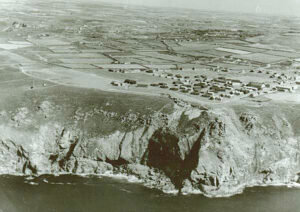 Cameron Estate (Photo: courtesy Clive Benney Collection)
Cameron Estate (Photo: courtesy Clive Benney Collection)
The village itself lay along the other side of the Beacon, the main street of Victorian houses and old cob cottages lay strung out along the upper edge of a valley. At the church, the road dropped steeply down to Peterville and from there, doubled back on itself again, down the wooded, but previously mine-ravaged valley, to the sea. Trevaunance Cove faced north, the harbour on its western side now a jumble of granite blocks after lack of maintenance following the advent of the railways which led to its demise.
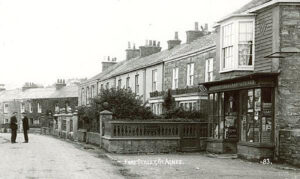 Vicarage Road (Fore Street) (Photo: courtesy Clive Benney Collection)
Vicarage Road (Fore Street) (Photo: courtesy Clive Benney Collection)
 Trevaunance Cove with the remains of the harbour to the right (Photo: courtesy Clive Benney Collection)
Trevaunance Cove with the remains of the harbour to the right (Photo: courtesy Clive Benney Collection)
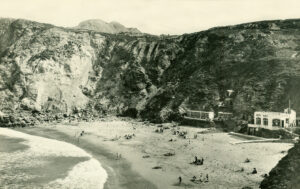 St Agnes Beach (Photo: courtesy Clive Benney Collection)
St Agnes Beach (Photo: courtesy Clive Benney Collection)
There were families who went down beach and families that didn’t, probably due to the fact that we walked both ways, down and up. Beach-loving families sat together, the kids sharing cake out of other mum’s cake tins. Dads were more rare as they were always working or digging the garden. At the back of the beach was a wall of beach stones which supported a row of stone-built huts which were mainly rented in summer by regular visitors who came year after year. The beach was our whole life in summer, we reluctantly trudged homewards on those long light evenings, home for tea.
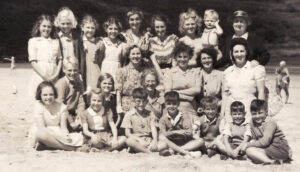 Mums and kids on the beach, and me – the baby, about 1947.
Mums and kids on the beach, and me – the baby, about 1947.
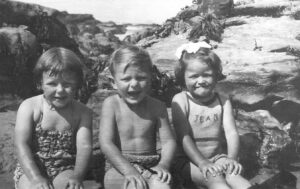 A Beach Trio: Victoria Carstairs, Michael Ricks and Jean Thomas.
A Beach Trio: Victoria Carstairs, Michael Ricks and Jean Thomas.
Our rented cottage, at the bottom of British Road, sat in a courtyard which my mother referred to as a suntrap. In the rich, dark, valley-bottom soil, with additions of seaweed, my father grew an array of vegetables, rows of lettuce and tall alleys of runner beans. The milkman delivered with his horse and cart, Queenie the horse knew where to stop and when to start up again. The coalman, Cyril, carried the sack on his shoulder and dumped it in our outhouse, which was also the icy cold toilet. The only local lorry was from the stock feed stores in Rosemundy, and it was with this lorry that we moved to a new council house when I was eight years-old and finally had a bathroom. In fact, we swapped our cosy cottage with its thick walls and Cornish Range for a cold bit of cheap but urgent post war building. The garden was a building site of rubble and Dad started all over again.
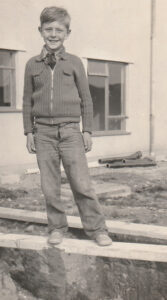 The Council House kid
The Council House kid
We kids roamed far and wide from an early age, across the cliffs to Cligga, Gadger, and the precipitous paths down to the rocky beaches, to Blue Hills, Jericho Valley, the burras of Wheal Kitty – we ran for miles and then ran home for dinner. We walked to school, rain or shine and on some exciting days, in snow. On those snowy days my Dad had to negotiate Barkla Shop and Town Hill in his green Western National double decker. And come home from Perranporth wet or cold on his motor bike, beret, greatcoat and waders.
There were the faintest of social levels in the village. You knew everyone, what job they did and how comfortably they lived, almost all were just plain working families. There were a few that owned businesses that made them slightly better off, there were a couple of families who were dirt poor, and just a few that seemed a cut above the others, a bit of inherited wealth, owned their houses, probably known as a boozy lot. We all went to primary school together and then the 11-plus exam and different levels of secondary school slowly peeled the layers apart as some left for careers and others stayed and toiled on farms, building sites or served in shops.
Things changed. The older workmen, the builders and farm labourers, off to work by bicycle with mac, flat cap and gas mask case for a croust bag: they gradually retired and faded from sight. A sprinkling of cars now parked outside in the street, second hand and hard to start on wet mornings. New people came to live, retire or commute to Truro. Where once stood engine houses, mine waste tips and shaft collars, bungalow estates spread across the fields. There was the first self-service supermarket, the first couple of cafes with frothy coffee and a juke box. The television replaced the family radio.
But let’s leave it there, at that point in time, that much loved village in its post-war, post-mining, sweet spot; the heart of a parish of farms and hamlets, pubs and chapels, from muddy lanes to wind-blasted cliff tops, on the mid north coast of Cornwall.
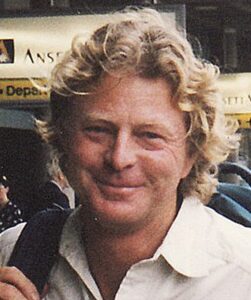 Mike Ricks
Mike Ricks
I was born and grew up in St Agnes. From Truro School I served in the Royal Navy before a career change into mining. I graduated from Camborne School of Mines in 1974 and worked in Northern Canada for six years before emigrating again to Australia where I am now retired in SE Queensland.

I was disappointed in Mike Ricks comment that Cameron Estate that the buildings were pretty shoddy. I lived on Cameron Estate. We were a family of four who survived a Spitfire that crashed into our cottage at Trevellas and we were homeless. My mother received £43.00 compensation as it was not enemy action! We were the first to arrive at no. 67b. I remember a bathroom and a separate toilet! a kitchen with a Truburn stove and a living room with a modern tiled fireplace. A garden we grew veg. in. A bus service, a shop a phone box and a theatre (briefly) The people I remember were ex prisoner of war, coast guards fire brigade members. All those people are now established St. Agnes families. Teagle workers. I remember a childhood on the cliffs and Chapel Porth and watching the sun go down. Our homes were better than the cottages of St. Agnes. Dr. Henry delivered a lot of babies on that estate.
We lived at 94b loved it
Wow my name was Pat Windsors and I lived at 96 Cameron Estate from early 1950. We lived next to the Johnsons @ 94 which was next door. Do you remember ? Yes there was a shop,phone box, & a quarry we used to play in and the main centre building at the entrance of the estate. We all walked to the school in British road come rain or snow in St Agnes then went to Penwethers School in Truro, the headmaster Mr. How hade a heart attach in our holiday they then appointed another H M and then he also died …and Penwethers is no more. So so sad as I was born I in Sidmouth Devon ..now gone ! St Agnes Primary School just appartments! Cameron Estate gone! Where am I now living in Paignton Devon ( happy unless Trump causes us problems) hope this is helpful ?
Thanks for your comment Pat. I’m guessing that you attended Penwethers when it opened, or maybe soon after. I attended from 1959 – in the second year (M) – and was the second head boy. Tony Mansell tonymansell4@outlook.com
Thanks, Mike. That brought back such a lot of memories. I was born Maureen Sandercock, 1944, so a bit older than you.
I’m waiting for your report on ‘the Club’, in the barn owned by Colin and Carlie Vincent’s parents.
I’ve returned to Cornwall, but to Lostwithiel. I still have a yen for St Agnes though. Maureen